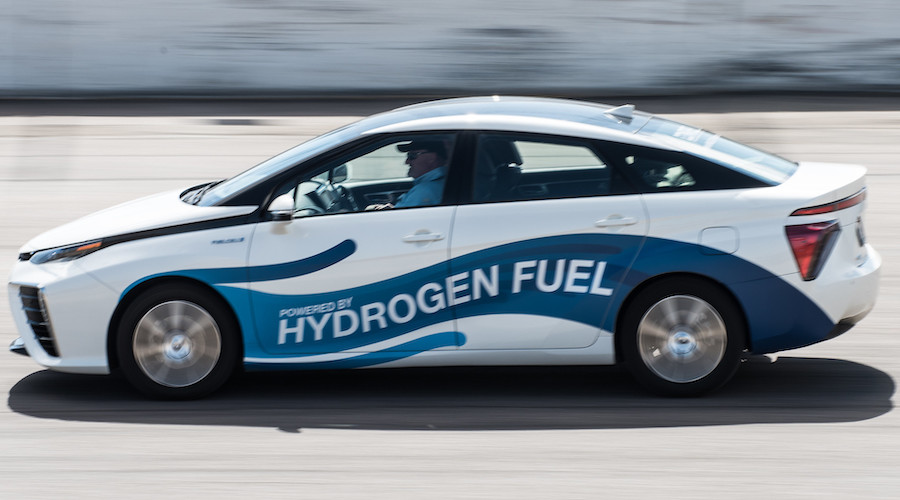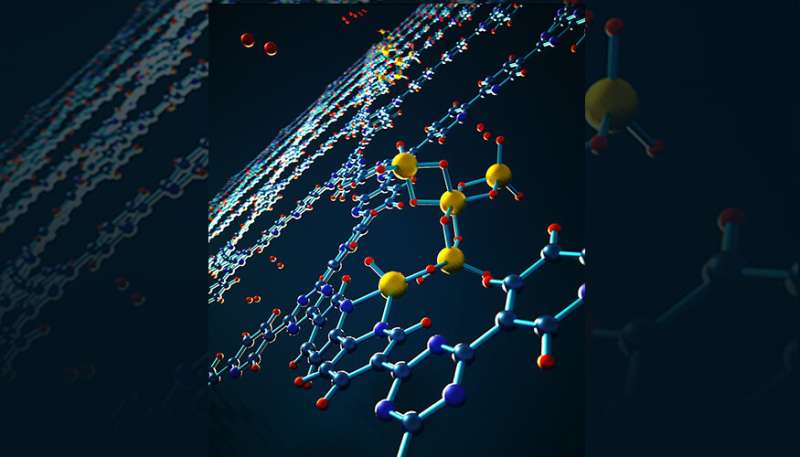GIF calls for nuclear's inclusion in COP26 discussions
29 October 2021
All realistic options that might contribute to global net-zero must be considered, the Generation IV International Forum (GIF) has said in an open letter to COP26 President Alok Sharma. Nuclear systems and advanced reactors - such as Generation IV systems - can contribute to a net-zero society alongside renewable energies, it says.
.jpg?ext=.jpg)
With delegates set to convene in Glasgow for the 26th UN Climate Change Conference of the Parties (COP26), GIF chair Hideki Kamide of the Japan Atomic Energy Agency said in the 25 October letter: "Achieving a global net-zero society in the near future - i.e. during the next 15 to 30 years - is no doubt an incredibly ambitious target to reach. However, it is our responsibility to use all of the possible technologies that we have at hand to realise a global, net-zero society. We must consider all realistic options that might contribute to global net-zero. To consider options from only a limited number of candidate technologies is not a practical attitude for our future."
GIF said that, as "a contributor to global net-zero", it joined the international initiative of the Clean Energy Ministerial Nuclear Innovation: Clean Energy Future (NICE Future) and has "further explained with other global net-zero contributors how nuclear energy can contribute to a global net-zero world" in a report entitled Flexible Nuclear Energy for Clean Energy Systems. This report, it notes, concluded that nuclear energy can work in harmony with renewables to expand the use of clean energy sources, and that nuclear energy is operating flexibly today in some forms, and innovation can lead to more pathways for nuclear flexibility.
"Since GIF started its activities as an international technical promoter of the next generation of nuclear reactors in 2001, considerable technical progress has been made in reactor development programmes," the letter says. "Moreover, GIF understands the importance of global net-zero and harmonisation with all net-zero technologies."
Last month, GIF published a report that said nuclear energy, as an asset class, has the potential to report well against a wide range of Environmental, Social and Governance (ESG) data collection and accounting metrics. The report - titled Nuclear Energy: An ESG Investible Asset Class - was produced by a finance industry taskforce set up in 2020 by GIF's Economic Modelling Work Group. The report describes how nuclear power, as an investible asset, can contribute to ensuring reliability and harmonisation in standards.
"For these reasons, GIF would like to join the global net-zero movement and contribute as a potential technical and financial partner," the letter states.
"Nuclear energy is a sustainable, safe, clean, reliable, flexible and affordable energy source for 24/7, and it has already been developed and is being used throughout the world. In other words, it is an existing option ready for use. Nuclear systems and advanced reactors, such as Generation IV systems, can contribute to this net-zero society, alongside renewable energies, through operational flexibility (load following, heat storage), deployment flexibility (scale, siting) and product flexibility (electricity and non-electric applications, such as process heat, hydrogen production or desalination). GIF is developing these promising technologies in collaboration with future builders in GIF member countries."
GIF said it is "very pleased that all possibilities, including nuclear power, will be on the agenda at COP26 and that realistic solutions will be discussed.
"COP26 can lead our future by taking advantage of human knowledge and wisdom. Again, we must emphasise the importance of considering all of the possibilities available today, without bias and exceptions, when we are deciding our future. Responsible actions for global net-zero will be essential, and the Generation IV International Forum, along with all nuclear promoters, is ready to contribute."
The GIF was initiated by the US Department of Energy in 2000 and formally chartered in mid-2001. It brings together 13 countries (Argentina, Australia, Brazil, Canada, China, France, Japan, Korea, Russia, South Africa, Switzerland, the UK and the USA), and Euratom - representing the members of the European Union - to work together to develop the research necessary to test the feasibility and performance of fourth generation nuclear systems, and to make them available for industrial deployment.
The six reactor technologies GIF identified for development are: the gas-cooled fast reactor, the lead-cooled fast reactor, the molten salt reactor, the sodium-cooled fast reactor, the supercritical-water-cooled reactor and the very high-temperature reactor. The OECD Nuclear Energy Agency provides GIF's technical secretariat.
Simon Irish, CEO of Terrestrial Energy, developer of the IMSR molten salt reactor, said the Canadian company "stands shoulder to shoulder with the Generation IV Forum and Japan Atomic Energy Agency in highlighting to the COP26 organisers the critical role of nuclear energy in achieving our global net-zero emissions goal."
"Nuclear energy is a proven, scalable and reliable carbon-free source," he said. "However, it is Generation IV that can change the whole commercial equation for nuclear power generation for only Generation IV technologies can deliver the step-change increase in the thermal efficiency needed to match the economics of fossil fuel generation."
UK government earmarks funds for progressing nuclear project
28 October 2021
The UK government has announced up to GBP1.7 billion (USD2.3 billion) in funding for a large-scale nuclear power plant in its autumn budget and spending review. It said it is in "active negotiations" with EDF over the Sizewell C project in Suffolk. The announcement comes days after the government introduced legislation for funding future nuclear power stations in the UK.
.jpg?ext=.jpg) (Image: UK Government)
(Image: UK Government)
In a statement about the measures announced yesterday by Chancellor Rishi Sunak in the autumn budget and spending review, the government said it would provide "up to GBP1.7 billion of direct government funding to enable a large-scale nuclear project to reach a final investment decision this parliament, subject to value for money and approvals."
In December 2020, the UK government announced it would begin talks with EDF Energy to enable investment in the planned Sizewell C nuclear power plant project. The latest government statement confirmed these negotiations are ongoing.
Other measures announced include GBP6.1 billion to back the Transport Decarbonisation Plan, boosting the number of zero-emission vehicles, helping to develop greener planes and ships, and encouraging more trips by bus, bicycle and foot. Sunak also confirmed funding for the GBP1 billion Net Zero Innovation Portfolio - as announced in Prime Minister Boris Johnson's Ten Point Plan for a Green Industrial Revolution, released in November 2020 - which is accelerating near-to-market low-carbon technology innovations and the aligned GBP385 million Advanced Nuclear Fund, which is developing the next generation of small and advanced modular reactor technologies.
The announcement was welcomed by UK trade body the Nuclear Industry Association. Tom Greatrex, the organisation's chief executive said: "This is a big vote of confidence in nuclear and a historic step forward for nuclear investment, with new money for a large-scale project, alongside money for modular reactors to enable future projects.
"We can't get to net-zero without investing in new nuclear capacity, and this is a clear signal from government to investors that it sees nuclear as essential to our clean energy transition. This is not only an investment in a greener future, but also in jobs and skills right across the country."
On 26 October, the government introduced the Nuclear Energy (Financing) Bill, which will use the Regulated Asset Base model to fund future nuclear power stations in the UK. The new funding model is expected to attract a wider range of private investment into new nuclear power projects, cutting the cost of financing them and reducing the cost to consumers.
The Sizewell C Consortium - a group of over 200 leading UK nuclear suppliers - also welcomed that announcement. Cameron Gilmour, spokesperson for the consortium, said: "The government has made a welcome and significant step forward in addressing our future energy needs, by outlining a framework for investment for nuclear in the UK. Sizewell C is a project that can start construction in this parliament - delivering jobs and apprenticeships, and much needed certainty for thousands of suppliers up and down the country."
Sizewell C will be a near replica of Hinkley Point C (HPC), which EDF Energy is building in Somerset and, like HPC, it will be able to supply 7% of the UK's electricity once it enters commercial operation. At about GBP18 billion (USD22 billion), EDF Energy has said that Sizewell C will be cheaper to build than HPC, the estimated cost of which is between GBP21.5 billion and GBP22.5 billion.
Under a strategic investment agreement signed in October 2016, China General Nuclear agreed to take a 33.5% stake in the HPC project, as well as jointly develop new nuclear power plants at Sizewell and at Bradwell, which is in Essex. The HPC and Sizewell C plants will be based on France's EPR reactor technology, while the Bradwell plant will feature the HPR1000 (Hualong One) design.
Net-zero easier and cheaper with nuclear, says French grid operator
28 October 2021
France can achieve its net-zero emissions target by 2050 through energy efficiency and electrification that would lead to a 35% increase in electricity demand, the French grid operator has said in a new report. Of the scenarios considered by Réseau de Transport d'Electricité (RTE), the cheapest implies constructing 14 large new nuclear power reactors, plus a fleet of small modular reactors, as well as significantly investing in renewables.
.jpg?ext=.jpg) (Image: RTE)
(Image: RTE)
As part of its legal mandate and in response to a referral from government, in 2019 RTE launched an extensive study of the evolution of the country's electricity system, titled Energy Futures 2050. The main findings of the study were presented by Xavier Piechaczyk, chairman of RTE's Management Board and Thomas Veyrenc, executive director in charge of the Strategy, Prospective and Evaluation division, during a press conference on 25 October.
"The French electricity system, unlike that of the majority of its neighbours, is not based on fossil fuels," the report notes. "Its main characteristic is that it rests mainly on a fleet of 56 nuclear reactors, mostly built and commissioned between the end of the 1970s and early 1990s ... Today, it is indisputable that it constitutes a major asset for France in the fight against climate change by producing largely carbon-free electricity in large quantities."
Nuclear accounts for almost 75% of France's power production, but former French president Francois Hollande said he aimed to limit its share of the national electricity generation mix to 50% by 2025, and to close Fessenheim - the country's oldest nuclear power plant - by the end of his five-year term, in May 2017. In June 2014, his government announced nuclear capacity would be capped at the current level of 63.2 GWe and be limited to 50% of France's total output by 2025. The French Energy Transition for Green Growth Law, adopted in August 2015, did not call for the shutdown of any currently operating power reactors, but it meant EDF would have to close older reactors in order to bring new ones online. However, under a draft energy and climate bill presented in May 2019, France will now delay its planned reduction in the share of nuclear power in its electricity mix to 50% from the current 2025 target to 2035.
Scenarios
RTE looked at six scenarios which considered future energy mixes exclusively based on renewable energy sources and those based on a mixture of renewables and nuclear. The scenarios differ primarily in the availability of nuclear capacity.
"In the short/medium term (2030-2035), the decision of shutting down nuclear reactors is a matter of political choice," the report says. "At this time, only two options exist to increase the production potential of carbon-free electricity: keep nuclear reactors in operation (the deadlines are in any case too close together to build new ones) and develop renewable energies.
"In the long term (2050-2060), the closure of second-generation nuclear reactors is an industrial constraint: in addition to supporting the expected increase in electricity consumption, French generating facilities will have to be radically renewed to replace production in the order of 380-400 TWh per year.
"It is in this perspective that it is necessary to replace the energy choices that France must make in the coming years: meet the double issue of a necessary increase in carbon-free electricity production capacity and a scheduled closure of the majority of the facilities that now meet this need."
RTE says that achieving carbon neutrality is impossible without a significant development of renewable energies. However, to do this without new nuclear reactors "implies faster development rates of renewable energies than those which have been achieved so far by the most dynamic European countries".
It says the need to build new thermal power plants based on carbon-free gas stocks (including hydrogen) is important if the revival of nuclear power is minimal and it becomes massive - and therefore expensive - if the energy system is based on 100% renewables.
'Economically relevant'
The construction of new reactors is "economically relevant", RTE says, all the more so when it makes it possible to maintain a fleet of around 40 GW in 2050 (with a combination of existing and new units). The study concludes "with a good level of confidence" that scenarios including at least a 40 GW nuclear fleet can lead, in the long-term, to lower costs for the community "than a scenario 100% renewable based on large parks".
One of the scenarios studied by RTE is for a nuclear generating capacity of 50 GW in 2050. This, it says, implies extending operation of most existing reactors to 60 years, to put into service 14 new EPR2-type reactors between 2035 and 2050 (mostly between 2040 and 2050) and to install in addition a significant capacity of small nuclear reactors. Such nuclear generating capacity "is likely to produce around 325 TWh in 2050. Such a volume is equivalent, in the benchmark consumption trajectory, of about 50% of national production."
Reaching a carbon neutral electricity system by 2050 can be achieved at a "manageable cost" for France, RTE says. By 2030, the country should develop mature renewable energies as quickly as possible and extending the operation of existing nuclear reactors increases the chances of reaching the target of a 55% reduction in emissions.
However, it notes: "Whatever the scenario chosen, there is an urgent need to mobilise."
Nuclear profits sustain Bulgaria in gas crisis
28 October 2021
Profits from Bulgaria's Kozloduy nuclear power plant are being redirected to provide subsidies of BGN110 (USD65) per MWh to industry. Some 630,000 industrial consumers will receive the benefit to protect them from power prices driven by gas.
.jpg?ext=.jpg) Two large VVER-1000s operate at Kozloduy, while four smaller VVER-440s are in decommissioning
Two large VVER-1000s operate at Kozloduy, while four smaller VVER-440s are in decommissioning
The measures were announced on 21 October by Prime Minister Stefan Yanev in a national address. He said the subsidy "will benefit over 630,000 non-residential end consumers" with the grant distributed automatically thanks to a contract between the government and the retail electricity suppliers, including the suppliers of last resort that have stepped in after other energy firms went bust.
The benefit will be backdated from 1 October and will last until 30 November, at an estimated cost of BGN450 million. Yanev said, "The funds will be provided from the state budget at the expense of the presentation of grants amounting to BGN450 million from Kozloduy nuclear power plant." He added, "In the next reporting year, the dividend due to be paid by [Kozloduy's owner] Bulgarian Energy Holding will be reduced by the indicated amount."
The upgraded subsidy improves on measures Yanev discussed on 19 October when speaking on TV1, which would have covered 250,000 businesses with a BGN30 per MWh payment. At the time, Yanev said subsidies would "support the economically weaker companies, which are also the largest employer in the country."
Having had elections in April and July this year but failed to form a government each time, Yanev and his cabinet are caretakers ahead of another election on 14 November. This means there is no functioning parliament and the government is not able to make any laws. "We hear the voice of everyone - the workers, the consumers of their goods, the employers. We know what the problems are and we are looking for solutions. They cannot appear with a magic wand," Yanev said.
Kozloduy is a large nuclear power plant in the northwest of Bulgaria on the Danube River that provides about 34% of the country's electricity. It features two VVER-1000 units in operation and four VVER-440 units which are being decommissioned.
Facing the need to phase out coal - which provides 40% of electricity - while also maintaining energy security, Bulgarian policymakers would like to expand nuclear capacity either at Kozloduy or at Belene, a new site also on the Danube. However, in a recent interview with Trud newspaper the chaiman of the Bulgarian Atomic Forum, Bogomil Manchev, said: "There is no longer an option for either one project or the other. The 'or' has disappeared."
Bulgaria is keen for the European Commission to decide positively that nuclear power can be included in its taxonomy of sustainable investments and is a member of the ten-nation 'Nuclear Alliance' of EU countries calling for this. Yanev raised the issue with the Vice President of the European Commission, Franz Timmermans, who visited Bulgaria earlier this month.
Researched and written by World Nuclear News



.jpg?ext=.jpg)
.jpg?ext=.jpg) (Image: UK Government)
(Image: UK Government).jpg?ext=.jpg) (Image: RTE)
(Image: RTE).jpg?ext=.jpg) Two large VVER-1000s operate at Kozloduy, while four smaller VVER-440s are in decommissioning
Two large VVER-1000s operate at Kozloduy, while four smaller VVER-440s are in decommissioning
.jpg?ext=.jpg) (Image: Pixabay)
(Image: Pixabay)


